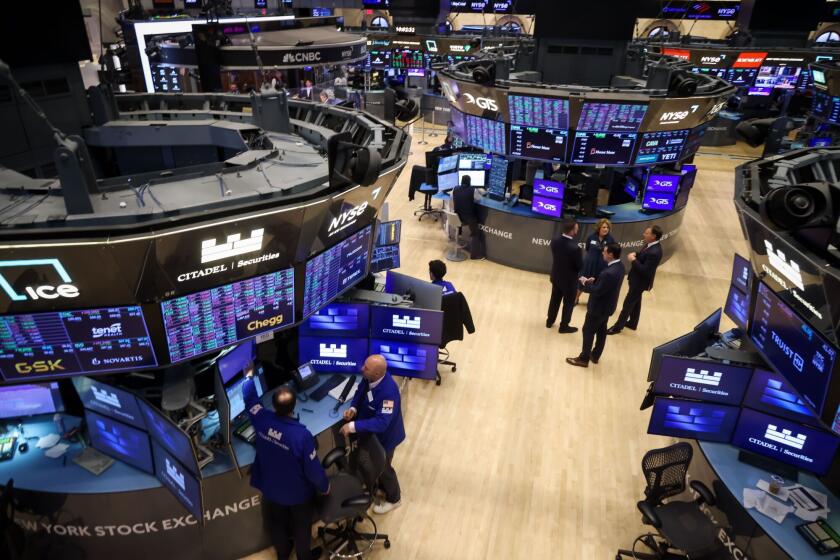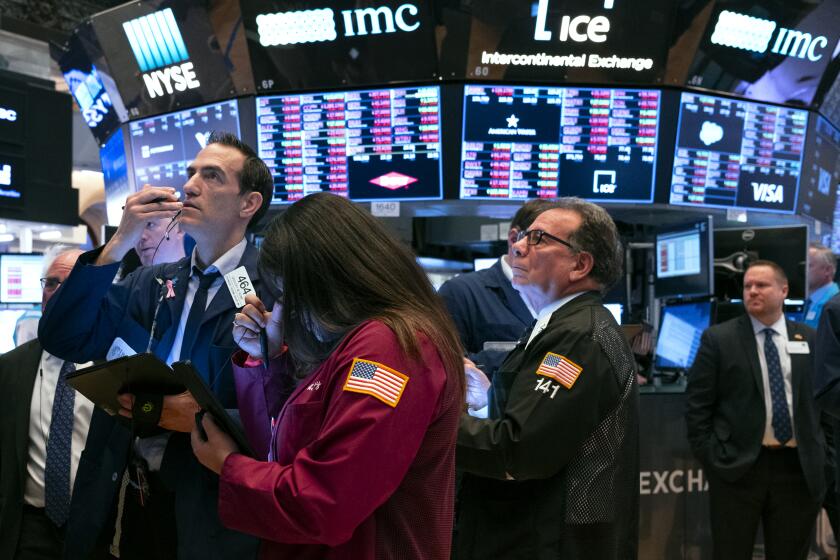Dow Declines 18.78 After Profit Taking : Market Overview
- Share via
Highlights of Tuesday’s market activity, compiled from Times staff and wire reports:
* Blue chip stocks gave back nearly half of the previous day’s sharp gains to profit taking and sell programs, while secondary shares moved ahead. The Dow Jones industrial average closed 18.78 points lower at 3,359.35 after gaining 42.04 points on Monday to a record high close of 3,378.13.
* In the credit markets, Treasury bond prices rose, boosted in part by a favorable response to an auction of new securities.
Stocks
Traders said institutional investors turned away from blue chip stocks after Monday’s rally and spread buying among other sectors, including technology and transportation.
Reflecting strength in the broader market, advancing issues edged out declining ones by about 6 to 5 on the New York Stock Exchange
Volume on the floor of the Big Board came to 200.55 million shares, up from 174.54 million on Monday.
The NASDAQ over-the-counter index gained 4.53 to 588.07.
“It is a mixed-up, muddled market that makes nervous new highs and keeps investors on their toes,” said Alan Ackerman at Reich & Co. “We are still in a restless rotation, and traders continue to hit and run.”
A rebound among technology stocks buoyed over-the-counter shares to a higher close, despite the pressure from Big Board weakness.
“The techs were strong and some biotechs are starting to bounce off their lows,” said Brett Discher, trader at Dain Bosworth.
Analysts said Monday’s record close in blue chips had deepened the disparity between the Dow and broader indexes, which they said could hamper the Dow’s ability to hit a new high soon.
The divergence could be corrected either by a selloff in the Dow or by a rally in the broader market. Analysts said it was not clear which scenario is more likely to occur.
Among the market highlights:
* International Business Machines continued its winning streak, adding 1 3/8 to 93 7/8. Traders said Shearson Lehman Bros. analyst Don Young reiterated his buy rating on the computer giant.
* ITT Corp. rose 2 3/4 to 66 3/4 after the company announced a larger-than-expected extension of its stock repurchase program, traders and analysts said.
* Limited Inc. also posted a second day of gains, advancing 1/4 to 23 3/4. Janney Montgomery Scott analyst Terence McEvoy reaffirmed a buy recommendation on the retailer’s stock.
* Rochester Telephone firmed 5/8 to 32 3/8 after Dan Dorfman reported on CNBC-TV that the company is rumored to be a takeover target.
* Apparel maker Gitano Group added 1 1/2 to 15. The company reported first-quarter operating income of 31 cents a share, compared to 16 cents a year ago.
* Among other NYSE actively traded issues, Chemical Bank strengthened 1/2 to 37 3/4, and Pepsico dropped 1/4 to 36 1/4.
In overseas trading, shares closed firmer on the London stock exchange as profit taking checked the market’s early assault on all-time highs. The Financial Times 100-share average finished 2.4 points higher at 2,662.2.
Shares clocked up their first closing gains in almost two weeks in Frankfurt. The 30-share DAX average ended 4.35 points higher at 1,732.64.
The Tokyo stock exchange remained closed for a public holiday and will reopen today.
Credit
The Treasury began its quarterly refunding auction, in which it will sell $36 billion in securities to replenish government coffers. Its first sale was $15.1 billion in three-year notes Tuesday.
The price of the Treasury’s bellwether 30-year bond rose 7/32 point, or $2.19 per $1,000 in face amount, by the close. Its yield, which falls when prices rise, was 7.997%, down from 8.016% late Monday.
Analysts said the results of the auction were reasonably encouraging, helping to boost the market for already outstanding securities. They believe that good demand for new issues is a sign of health for the overall Treasury bond market.
Today, the Treasury plans to auction $11 billion worth of 10-year notes, and on Thursday, $10 billion worth of 30-year bonds.
In the secondary market for outstanding Treasury bonds, short-term maturities were 1/16 point to 5/32 point higher, intermediate maturities were 3/16 point to 11/32 point higher, and long-term issues were 3/16 point to 7/32 point higher, the Telerate Inc. financial information service reported.
The movement of a point equals a change of $10 in the price of a bond with a $1,000 face value.
The federal funds rate, the interest on overnight loans between banks, rose to 3.750% from 3.625% late Monday.
Currency
The dollar settled mostly lower in rumor-driven trading on world currency markets.
Trading was initially subdued by the absence of Japan, where financial markets were closed for the second consecutive day because of a national holiday.
In Britain, where markets also were closed Monday for a holiday, major banks responded to a signal from the government by cutting their base lending rate by half a percentage point to 10%.
It was the lowest level in three years and helped spur trading even though the move had been expected. The central bank gave a hint last week when it eased its money market rates a bit.
The pound strengthened on the news, but speculation about German interest rates appeared to dominate the market.
“The mark was strong due to speculation that the Bundesbank, at its Thursday council meeting, might raise interest rates,” said Randolph Donney, director of research at Pegasus Econometric Group in Hoboken, N.J.
That possibility, coupled with speculation that the Federal Reserve might lower interest rates here to give the economy another jolt, worked to undermine the dollar.
“People were making the leap in logic and selling dollars before they have actual proof that that’s what the Fed has to do,” Donney said.
As yields rise overseas, U.S. investors have a greater incentive to put their money abroad, thereby increasing their need for foreign currencies at the expense of the dollar.
Trading was “fairly choppy” as the dealers marked time until the release of the unemployment report, the first piece of fresh economic data to hit the market all week, Donney said.
In New York, the British pound rose to $1.786 from $1.779 in Europe late Monday.
The dollar settled in New York at 132.90 Japanese yen and 1.638 German marks, down from 133.20 yen and 1.647 marks respectively on Monday.
Commodities
Wheat futures prices fell, ending a two-day surge on forecasts for rain later this week in key winter wheat growing areas.
Wheat for delivery in May fell 4.75 cents to $3.83 3/4 a bushel on the Chicago Board of Trade.
Hog futures fell sharply; cattle futures were mixed on the Chicago Mercantile Exchange.
Elsewhere, oil prices fell, reversing gains from Monday’s rally.
Light, sweet crude oil for delivery in June settled at $20.80 per barrel, down 32 cents, at the New York Mercantile Exchange. In the previous session, oil had risen 27 cents to its high point for the year.
There was no news moving the market. But many traders seemed to have developed a consensus that OPEC won’t cut production when the cartel meets later this month, said Peter Beutel, an oil analyst at Pegasus Econometric Group Inc. in Hoboken, N.J.
Silver futures rose sharply on New York’s Commodity Exchange, leading gold higher. June gold rose 20 cents to $337.80 an ounce, and May silver jumped 5.2 cents to $4.054 an ounce.
Market Roundup, D6
More to Read
Inside the business of entertainment
The Wide Shot brings you news, analysis and insights on everything from streaming wars to production — and what it all means for the future.
You may occasionally receive promotional content from the Los Angeles Times.









